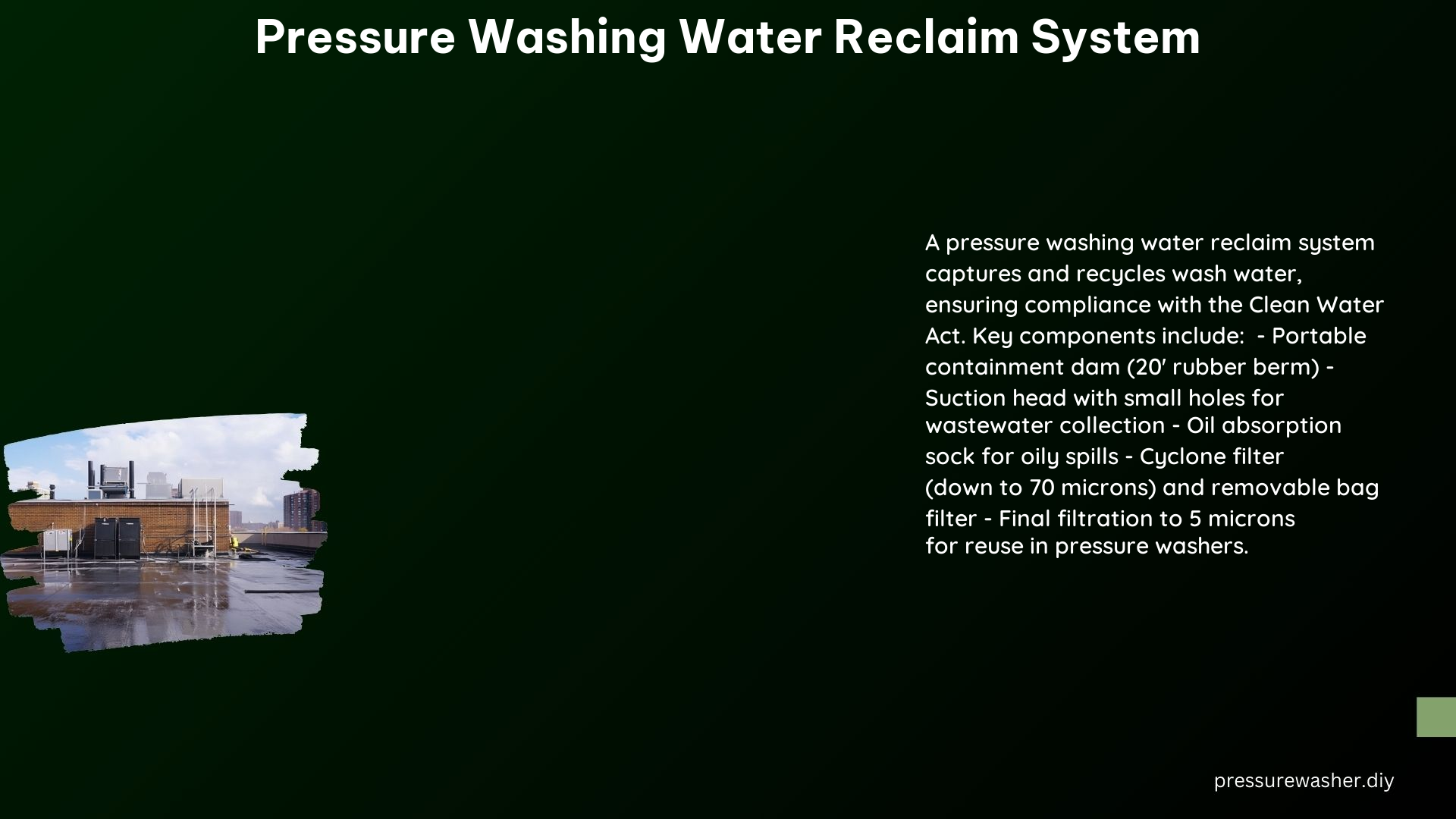Pressure washing is an effective way to clean various surfaces, but the wastewater generated can pose environmental concerns. To address this issue, pressure washing water reclaim systems have been developed to capture, filter, and recycle the wash water, ensuring compliance with environmental regulations and protecting local waterways. In this comprehensive guide, we will delve into the technical specifications, components, and best practices for implementing a pressure washing water reclaim system.
Understanding the Importance of Water Reclaim Systems
Pressure washing generates significant amounts of wastewater, which can contain a variety of contaminants such as dirt, grease, oil, and chemicals. Improper disposal of this wastewater can lead to environmental damage and hefty fines from regulatory bodies like the Clean Water Act. By implementing a water reclaim system, pressure washing businesses can not only comply with environmental regulations but also reduce their water consumption and operating costs.
Key Components of a Pressure Washing Water Reclaim System

A typical pressure washing water reclaim system consists of several essential components that work together to capture, filter, and recycle the wash water. Let’s explore these components in detail:
Containment Dam
The containment dam is a crucial element that creates a controlled area for the wastewater to be collected. These dams are often made of rubber or other durable materials and can range in size from 20 feet to larger dimensions, depending on the scale of the pressure washing operation.
Suction Head
The suction head is responsible for collecting the wastewater from the containment area. It features small holes or slots that allow the water to be efficiently drawn into the system, while larger debris is prevented from entering.
Collection Tank
The collected wastewater is stored in a dedicated collection tank, which can range in size from 250 gallons to larger capacities, depending on the volume of water generated during the pressure washing process.
Oil Absorption Sock
To remove oil and other floating contaminants, the water reclaim system often includes an oil absorption sock. This specialized component helps to separate oil and grease from the water, ensuring a cleaner final product.
Cyclone Filter
The cyclone filter is designed to remove larger particles and solids from the wastewater. This component uses centrifugal force to separate the heavier particles from the water, preparing it for further filtration.
Removable Bag Filter
The final stage of filtration is the removable bag filter, which can capture particles down to 5 microns in size. This ensures that the recycled water is clean and suitable for reuse in the pressure washing equipment.
Advanced Pressure Washing Water Reclaim Systems
In addition to the basic components mentioned above, some pressure washing water reclaim systems offer more advanced features and capabilities:
Vacuum-Only Systems
These systems focus solely on the vacuum aspect, collecting the wastewater without any additional filtration. They are often used in situations where the water can be discharged into a sanitary sewer system or approved dumping station.
Vacuum with Filtration Systems
These systems combine the vacuum function with various filtration stages, including cyclone filters and bag filters, to provide a higher level of water treatment and enable the recycling of the wastewater.
Vacuum with Filtration and Recycling Systems
The most advanced pressure washing water reclaim systems incorporate both filtration and a recycling mechanism. These systems can filter the wastewater to a high degree and then pump the clean water back into the pressure washing equipment, minimizing the need for fresh water and reducing operating costs.
Retrofitting Existing Pressure Washers
For businesses with existing pressure washing equipment, there are options to retrofit the systems with water reclaim capabilities. Manufacturers like Superior Cleaning Equipment offer mobile wash water recovery systems that can be integrated with existing pressure washers, allowing for a cost-effective upgrade to a water reclaim setup.
DIY Water Reclaim System Options
For those looking to build a more budget-friendly water reclaim system, there are DIY options available. One example is a setup using a boat bilge pump, a car battery, and some basic tubing, which can be constructed for under $100. While these DIY solutions may not offer the same level of sophistication as commercial systems, they can still provide a viable way to capture and recycle wash water.
Conclusion
Pressure washing water reclaim systems are essential for businesses and individuals looking to comply with environmental regulations, reduce water consumption, and minimize their environmental impact. By understanding the key components, advanced features, and DIY options, you can implement a water reclaim system that meets your specific needs and helps you operate in a more sustainable and cost-effective manner.
References:
- Pressure Wash Outlet. (n.d.). PRESSURE WASH RECLAIM & RECOVERY EQUIPMENT. Retrieved from https://pressurewashoutlet.com/collections/reclaim-recovery-equipment?srsltid=AfmBOooVI_SUpKJHR_TjCY7OEfZcSW52aKfB0Ssi5F2zab1P1vzEYXd8
- Reddit. (2021, April 12). Do I need a water reclamation system if I’m going to be using chemicals? Retrieved from https://www.reddit.com/r/pressurewashing/comments/mpgtcc/do_i_need_a_water_reclamation_system_if_im_going/
- Mi-T-M. (n.d.). How to Use A Portable Water Reclaim System. Retrieved from https://www.mitm.com/support/videos/how-to-use-a-portable-water-reclaim-system/
- Superior Cleaning Equipment. (n.d.). Wash Water Recovery Systems. Retrieved from https://sceclean.com/product-category/industrial-equipment/wash-water-treatment/mobile-wash-water-recovery-recycling/
- Powerwashstore. (n.d.). Recovery Vacuum Systems. Retrieved from https://www.powerwashstore.com/C/35/Recovery-Vacuum-Systems
